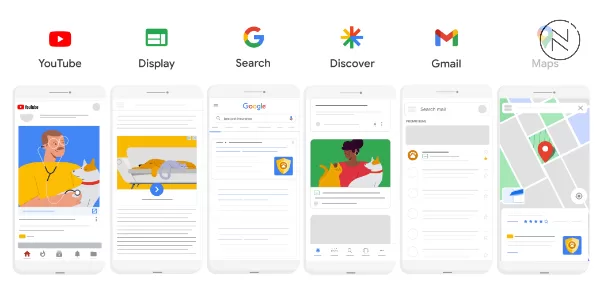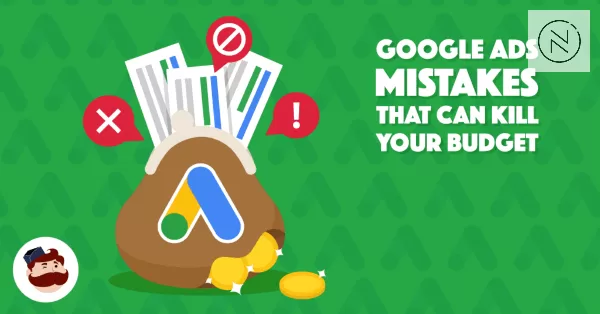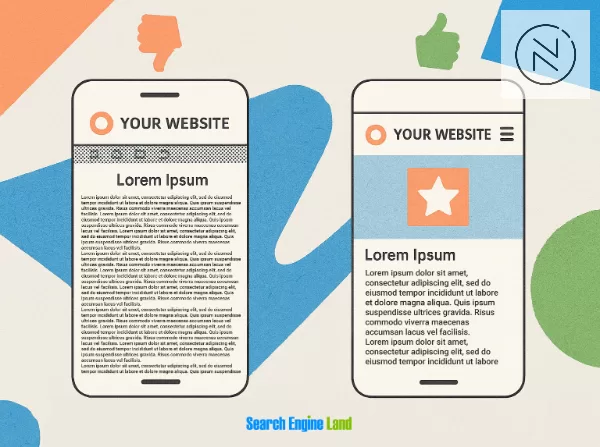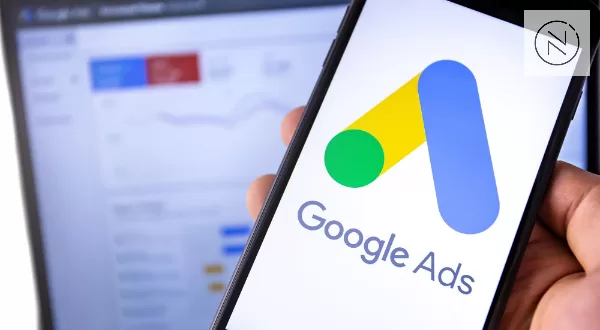Insights
Google Ads Mistakes: A Checklist of 9 Costly Errors Every Marketer Needs To Avoid In 2025
On Digitals
13/10/2025
26
Running ads on Google is a powerful way to reach customers, yet even experienced marketers often fall into common Google Ads mistakes. This guide provides a checklist of 9 costly errors every marketer should avoid, along with tips on how to fix them before launching or optimizing a campaign.
In the section below, On Digitals will provide a quick understanding of how the platform works and why avoiding these mistakes is crucial for ad performance.
Overview About the Google Ads
Google Ads is the online advertising platform developed by Google, with the core mission of helping businesses attract target customers effectively. The platform allows you to achieve various goals, such as increasing website traffic, boosting search visibility (traffic), or driving direct actions like receiving calls, messages, and increasing company sales.
Advertising on Google Ads is completely flexible according to your business budget. When potential customers search for the products or services you offer on Google’s search engine, your business’s ad will appear directly on the search results page. You only pay for each interaction (such as a click on the ad or an impression) based on your established bidding strategy.
Common Types of Google Ads
Google Ads offers a wide array of advertising formats. It’s crucial that you understand the characteristics of each format to select the one that best aligns with your core business objectives.

Some types of Google Ads
Here are some popular formats you should consider:
Google Search Ads
This format is based on users’ search keywords. When a customer enters a term related to your product or service, your ad is displayed immediately on the search engine results page (SERP). The primary goal is to reach potential customers exactly at the moment they express a need.
To be highly effective, this format requires thorough keyword research to optimize your budget and avoid wasting ad spend.
Gmail Ads
This is an effective form of email marketing, particularly suitable for mid-range or premium products. Gmail Ads reach users directly through their primary inbox or categorized tabs like Social and Promotions within Gmail. This format allows you to deliver personalized advertising messages to a precisely defined audience.
YouTube Video Ads
As a core Google product, YouTube boasts a vast and diverse user network, creating a massive opportunity for customer engagement through video advertising. Depending on your budget, you can choose various ad formats, such as: Skippable In-stream Ads (which typically have a lower cost), Non-skippable In-stream Ads, Bumper Ads (short, 6-second spots), among many others to meet all your business’s visual marketing needs.
Furthermore, there are many other formats like Google Shopping Ads, Google Smart Campaigns, and more. A comprehensive understanding of these options will help your business implement the most effective strategy.
Which Ad Type Should Beginners Choose?
To manage costs effectively and maximize intent-based marketing, beginners should primarily focus on Google Search Ads. This format is highly efficient because it captures users at the very end of the sales funnel—when they are actively searching for a solution. By targeting precise, high-intent keywords, you can achieve a strong Return on Ad Spend (ROAS) even with a modest budget.
Alternatively, if your marketing objective is to rapidly build brand recognition (brand awareness) and you have a larger budget, you might consider utilizing the Google Display Network (GDN). The GDN allows you to showcase visually appealing banner ads across millions of websites, apps, and platforms, achieving broader reach among your target audience. While the conversion rate may be lower than Search, the increased brand visibility can significantly contribute to long-term market presence and trust.
Why Should You Use Google Ads in Your Strategy?
Google Ads is vital to any strategy because of its unparalleled data ecosystem. Powered by a sophisticated machine learning system, Google collects vast data on global user behavior—from search queries to activity across platforms like Gmail and YouTube. This holistic view allows you to target specific customer groups with high precision using features like Customer Match and In-Market Audiences, and to maximize ROI through Smart Bidding.

Why should you use Google Ads in your strategy?
However, this complexity means success isn’t guaranteed. To truly capitalize on this advanced targeting power, you must master the basics and avoid the biggest Google Ads mistakes that often drain budgets. Ignoring common errors can nullify the platform’s advantages. Now, let’s explore the most frequent and costly Google Ads mistakes to avoid to ensure your campaigns achieve maximum profitability.
Checklist of 9 Costly Google Ads Mistakes You Should Know.
Mistake: Neglecting the Emotional Element in Ads
One of the biggest Google Ads mistakes is treating advertising solely as a means of delivering product information. If your messaging consists only of dry text without the visual, audio, or video elements needed to create an emotional atmosphere, you will struggle to capture and retain the viewer’s attention.
Effective advertising must appeal to higher human needs, specifically the need for love, affection, and belonging, as described in Maslow’s hierarchy of needs. To optimize your campaign’s effectiveness, consider engaging the viewer’s psychology in the following ways:
- Create Empathy: Directly address the customer’s pain points or problems, while showing understanding and respect for that pain. This immediately builds an emotional connection.
- Trigger FOMO (Fear of Missing Out): Highlight the product’s unique features, scarcity, or the benefits that others have already embraced and achieved. This encourages quick action out of fear of missing the opportunity.
- Provide Real-World Evidence and Build Trust: Use authentic elements such as customer testimonials (social proof), present success metrics or revenue figures, and display credible certifications to establish strong trust.
Mistake: Ignoring Negative Keywords
This “Google Ads mistakes” is one of the most budget-draining errors is neglecting the use of Negative Keywords. If you fail to establish a robust negative list, your ads will appear for irrelevant or non-buying search queries.
This not only wastes budget unnecessarily (as you pay for worthless clicks) but also decreases your website’s Click-Through Rate (CTR), which can negatively impact your Quality Score.

Google Ads mistakes that can kill your budget
To address this issue and optimize campaign efficiency, you must take the following actions:
- Frequently Add Negative Keywords: Regularly review and eliminate keywords that have triggered your ads but have not resulted in qualified leads or sales, ensuring your money is spent only on relevant traffic.
- Analyze the Search Terms Report: This is the most crucial tool for accurately identifying the “junk” or irrelevant keywords that triggered your ads. Analyzing this report is an essential step toward continuously cleaning up your keyword list.
- Update Content & Track Cyclically: Ensure your landing page content is highly relevant to your chosen keywords. Simultaneously, track your keyword performance on a regular cycle to maintain continuous optimization.
Mistake: Targeting Too Broad an Audience
This is a costly Google Ads mistakes that is particularly common when utilizing the Display Network or Video Ads. Running campaigns with an excessively wide audience scope (Broad Targeting) causes your budget to be quickly depleted on users with no real buying intent, leading to low conversion rates and serious budget waste.
To transition from mere “exposure” to “precise targeting” and optimize your ad spend, you need to:
- Utilize Audience Segments: Instead of generic targeting, focus on specific customer groups based on their interests, habits, or buying intent (In-Market Audiences).
- Refine Demographics and Geography: Regularly adjust factors like geography, age, and gender to ensure your ads are only shown to users who truly align with your product and your ideal customer profile.
- Prioritize Retargeting (Remarketing): Focus budget allocation on remarketing to users who have previously engaged with your website or YouTube channel. This group has the highest conversion rate because they have already demonstrated prior interest.
Mistake: Overlooking Mobile Optimization
Most users now perform the majority of their searches and purchases on mobile devices, yet many marketers forget that failing to optimize their landing pages and overall mobile experience is one of the costliest Google Ads mistakes. If your website loads slowly or has a cluttered interface on a phone, the bounce rate will soar, and your advertising money will be wasted.

User Experience Optimization
To ensure effectiveness, take the following steps:
- Use a Responsive Landing Page: Ensure your landing page has a smooth interface and fast loading speed on all mobile screen sizes.
- Test Page Load Speed: Use the Google PageSpeed Insights tool to check and improve mobile load times, as speed is a crucial Google ranking factor.
- Optimize Mobile CTAs: Place Call-to-Action (CTA) buttons in prominent, easy-to-use locations (easy to tap) and utilize features like Call Extensions so customers can call immediately.
Mistake: Not Setting Up Conversion Tracking
If you aren’t tracking conversions, you’re flying your ad campaign blind. This common Google Ads mistakes means you don’t know which campaigns or keywords are actually generating revenue. Spending money without accurate measurement is the fastest route to budget waste.
You must address this by:
- Installing a Tracking System: Accurately set up Google Ads Conversion Tracking or utilize Google Analytics 4 (GA4) to link conversion data.
- Tracking Diverse Conversion Types: Don’t just track purchases, track other valuable actions like newsletter sign-ups, lead form submissions, or quote requests.
- Analyzing ROI (Return on Investment): Continuously analyze the return on investment (ROI) from conversion data to allocate your budget reasonably and effectively.
Mistake: Neglecting Quality Score and Improper Bidding
Many advertisers only focus on the bid price while ignoring the single most important factor in Google Ads: the Quality Score. This is an extremely costly Google Ads mistakes because a low Quality Score will force you to pay a much higher Cost Per Click (CPC) than your competitors, even if your bids are comparable.
To address this issue and significantly improve your spending efficiency, you need to:
- Focus on Improving Quality Score: Quality Score is based on three main factors: Ad Relevance, Expected Click-Through Rate (Expected CTR), and Landing Page Experience. You must optimize all three elements simultaneously.
- Utilize Smart Bidding Strategies: Instead of relying solely on manual bidding, leverage Google’s Smart Bidding strategies (such as Maximize Conversions or Target CPA) after you have accumulated sufficient conversion data. This allows the system to automatically adjust bids to achieve your goals at the most effective cost.
- Ensure Tight Content Linkage: Guarantee that your Keywords, Ad Copy, and Landing Page Content are logically and tightly linked together. This tight connection is the fundamental basis for increasing your Quality Score.
Mistake: Forgetting Ad Extensions
Ignoring Ad Extensions means missing a golden opportunity to expand your ad real estate, attract more clicks, and boost your Click-Through Rate (CTR). This is one of the easiest Google Ads mistakes to avoid that many still make.
Maximize your use of the following extensions:
- Sitelink Extensions: Use these to direct customers to other important pages on your website (e.g., Pricing Page, Contact Us, Special Offers).
- Callout Extensions: Emphasize special offers, free services, or exclusive advantages (e.g., Free Shipping, 24/7 Consultation).
- Call & Location Extensions: Essential for businesses with physical stores. They increase credibility and make it easier for customers to contact or navigate to your location.
Mistake: Poor Budget Allocation
Many marketers make the serious error of distributing their budget evenly across all campaigns instead of focusing resources on the highest-performing ones. This reduces overall efficiency and hinders scalability.

The poor budget allocation
The principle of proper budget allocation is:
- Prioritize High-ROI Budget: Based on conversion data, focus the majority of your budget on the campaigns, ad groups, or keywords that are generating the highest return on investment (ROI).
- Adjust Based on Conversion Data: Make decisions to increase or decrease the budget based on actual performance (data) rather than subjective feelings or assumptions.
- Set a Reasonable Daily Cap: Set appropriate daily spending limits to prevent your budget from “burning out” too early in the day, ensuring ads are distributed consistently.
Mistake: Not Testing and Optimizing Continuously
A major and common error is running ads and then adopting a “Set-it-and-Forget-it” approach, failing to conduct continuous A/B testing and optimization. Advertising is not a fixed formula, it needs constant adjustment to adapt to the market.
To overcome this crucial Google Ads mistake to avoid, you must:
- Always Perform Comprehensive A/B Testing: Test every element: headlines, descriptions, CTAs, and even the landing page. This is the only way to find the optimal version.
- Monitor Performance Regularly: Track and evaluate performance (CTR, CPC, CPL) on a weekly basis rather than just checking at the end of the month.
- Eliminate Poor-Performing Ad Groups: Be decisive in removing underperforming Ad Groups or keywords, and reallocate that power and budget to the groups that are performing better to maximize overall efficiency.
While Google Ads is an incredibly powerful platform, its complexity demands vigilance. Mastering these pitfalls is the foundation of turning ad spend into profitable revenue. By consistently implementing the solutions discussed, you move from passively managing campaigns to actively driving success.
FAQ: Google Ads Mistakes: A Checklist of 9 Costly Errors Every Marketer Needs To Avoid
1. What are the most common Google Ads mistakes in 2025?
Some common mistakes include neglecting negative keywords, poor budget allocation, overlooking mobile optimization, weak ad copy, and not setting up conversion tracking.
2. Why are Google Ads mistakes so costly for businesses?
These mistakes waste budget on irrelevant clicks, lower Quality Score, reduce CTR, and fail to generate conversions, directly impacting ROI.
3. How can beginners avoid costly Google Ads mistakes?
Start with Search Ads, use targeted keywords, set up conversion tracking, and monitor campaigns weekly. Avoid broad targeting and always A/B test ad copy.
4. What is the easiest Google Ads mistake to avoid?
Forgetting ad extensions is one of the simplest mistakes to fix. Using sitelinks, callouts, and call/location extensions can quickly boost CTR and engagement.
5. How does mobile optimization impact Google Ads performance?
Mobile optimization directly affects ad performance. A slow or poorly designed mobile landing page increases bounce rates, lowers Quality Score, and wastes ad spend, while a fast, responsive page improves conversions.

Ways mobile optimization impact Google Ads performance
Avoid Google Ads Mistakes in 2025 with On Digitals
Mastering Google Ads requires more than just launching campaigns, it’s fundamentally about avoiding common Google Ads mistakes that drain budgets and reduce performance. From neglecting negative keywords to overlooking mobile optimization or skipping conversion tracking, each of these Google Ads mistakes can directly and severely impact your ROI. By recognizing and actively fixing these pitfalls, marketers can ensure their ad spend drives measurable results and sustainable long-term growth.
At On Digitals, we specialize in helping businesses navigate the complexity of Google Ads. Our team provides tailored strategies, continuous optimization, and data-driven insights to eliminate costly errors and maximize every campaign’s potential. Partner with us to turn your advertising investment into sustainable success in 2025 and beyond.
NEWEST POSTS
- A Complete Guide to Programmatic Advertising for Digital Campaign Success
- A Complete Guide to Influencer Marketing ROI for Better Performance
- Account Based Marketing For B2B Teams Seeking Stronger Growth
- How To Spot Fake Followers On Influencer Profiles And Boost ROI
- Nano Vs micro influencers: Key differences And Best Uses
Read more
